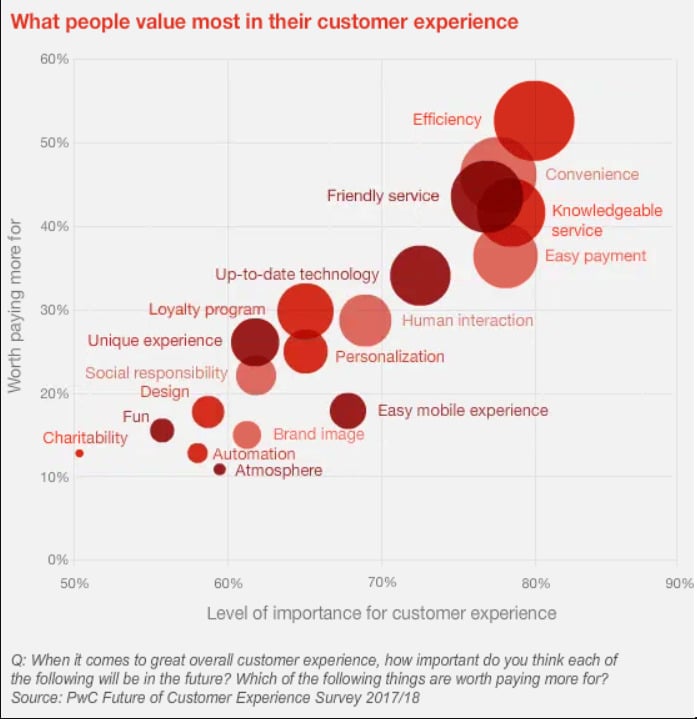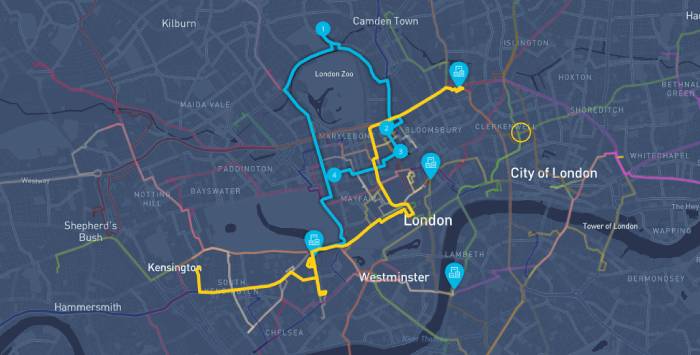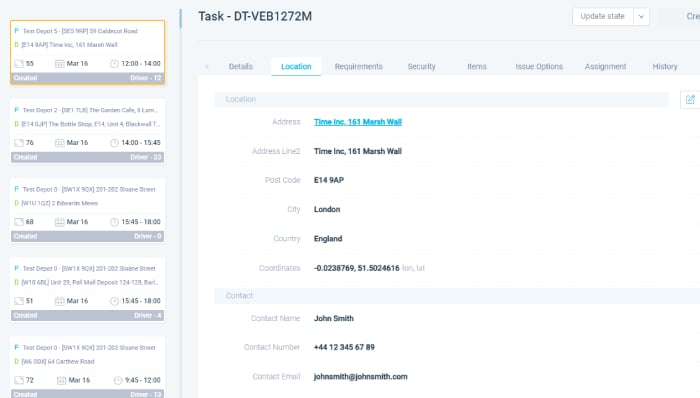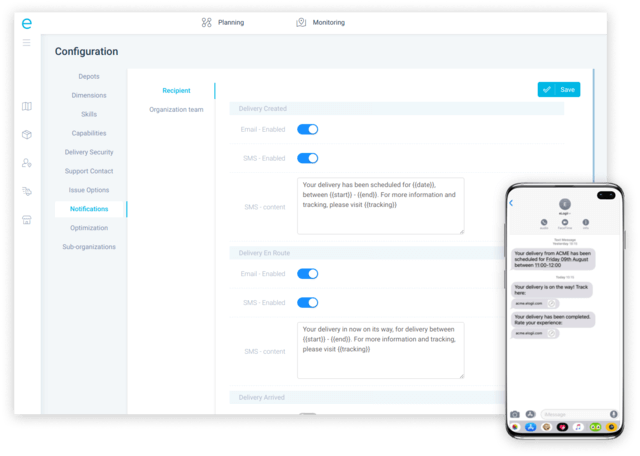How to Provide Accurate Delivery Windows to Customers [2025]
Are you providing accurate delivery time windows to customers? ETAs and delivery windows tell customers when to expect their orders and #1 to build...
Home > Blog > Building Trust with Your Customers Through Delivery
Customer Experience ManagementToday, we take a look at trust. And how you can use your delivery to build trust with your customers.
Today, we take a look at trust. And how you can use your delivery to build trust with your customers.
To be clear:
How you build trust with customers depends on the type of business and delivery that you own and operate.
For example, an e-commerce delivery will be different from a physical retailer or a food delivery.
That said, there are several ways you use delivery management software to achieve this:
#1 Provide Multiple Delivery Options
#2 Let Customers Self-Schedule
#3 Deliver Orders Faster
#4 Collect Delivery Data
#5 Create Customer Profiles
#6 Personalize the Delivery Experience
#7 Put a Face to Your Delivery
#8 Be Transparent
#9 Prioritize Return Customers
Customers still expect you to offer multiple delivery options at checkout.
According to delivery statistics, people want at least three delivery options besides standard delivery (usually 2-day delivery).
Just take a look at Amazon’s shipping options for their Prime users:
Amazon has an additional 20+ delivery options available besides these.
Now, you shouldn’t follow Amazon’s example, option per option.
According to the psychology of choice, this may lead to choice overload.
In her TED talk How to Make Choosing Easier, Sheena Iyengar, Professor of Business at the Columbia Business School, explains this.
So if you want to know how to compete with Amazon, you’ll have to offer a few different delivery options, at least.
Some of the most popular on-demand delivery options include:
The main thing to remember is that you should only add delivery options that your operations can actually handle.
And that’s where delivery management software can help you.
Making your delivery operations more efficient and agile enables you to add more choices.
For example, you can use the software to offer free delivery to your customers.
It lets you add this option without transferring the costs to the consumer. Or raising operational expenditure so you can’t afford it.
At the same time, you get greater visibility over the last mile.
This removes the risk of late or missed deliveries.
So even though it may seem that various delivery options are out of your grasp, they’re NOT.
Automation helps you add them to your offer without damaging the relationships you have with your customers.
But by adding them, you can raise the level of trust they place in your services.
Another thing customers want a say in is when the delivery will arrive.
Typically, companies send a confirmation email with an approximate date and time of the delivery. For example:
Thank you for ordering from us. Your item will arrive within 2-3 business days.
But this isn’t very convenient. Customers would have to stay at home and wait for the order, not knowing when exactly it will arrive.
Because most customers don’t have the time to wait anymore, this can lead to missed or failed deliveries.
If that’s the case, this kind of delivery service isn’t very efficient for you or your customers.
In fact, a survey shows how convenience and efficiency are the top values people want to see in a quality customer experience.

But traditionally, allowing customers to choose the date, let alone the time of their delivery is a logistical nightmare.
It’s also almost impossible to do if you’re manually planning deliveries.
But this is where delivery management software like eLogii comes into play.
First, it automates how you plan deliveries. It speeds up the process and makes it possible to adjust schedules and routes, even as drivers prepare to set off on their delivery runs.
At the same time, you can use a routing API to integrate the software with any third-party platform. This includes order management systems and CRMs such as Shopify or WooCommerce.
You can connect the delivery platform to your online store and allow customers to choose the exact time and date of the delivery from the list of available slots.
When a customer chooses a slot, the system automatically removes it from the list. While the task is added to the schedule of a driver, based on his availability and delivery route.
Besides efficiency and convenience, consumers also want speed.
Your customers want you to deliver their orders as fast as possible.
After Amazon introduced rapid fulfillment, people wanted to receive purchases on the same day they made the order request.
In fact, people want fast delivery so much that 88% of consumers don’t mind paying for it if it means they’ll receive their purchase sooner.
And this is twice as important if you run an e-commerce business. As a report by McKinsey puts it:
Same-day delivery combines the convenience of online shopping with the immediate product access of stationary retail.
But even when you decide to add next-day or same-day fulfillment to your offer, it’s difficult to build an agile delivery operation that can support it.
This is where delivery management software can help.
This type of software is a dynamic solution. That means you can plan, manage, and dispatch deliveries in real-time, while your drivers are already dropping off orders.

Because the entire process is automated, it takes you less than 30 seconds to plan or adjust routes and delivery schedules.
So if you have available time slots in your schedule, you can add new tasks to a driver’s route and complete the order request as soon as it is logged on the platform.
And because the routes are optimized, the cost per delivery is lower, as well. So it’s more cost-effective to offer same-day delivery.
If you want, you can even offer same-day delivery at no extra cost to your customer.
And that can make you highly competitive, especially since 95% of people choose fast free delivery as their preferred delivery method.
So even if you’re losing money on free same-day delivery, you’re generating a lot more profit from the larger order volumes.
Since customers will always choose your faster delivery over a standard service of your competitors.
One of the key ingredients of building trust is to focus 80% of your attention on creating a quality delivery experience.
And how do you do that?
You listen to customers.
Specifically, you’ll want to learn what they have to say when it comes to:
And the only way to know the answers to these questions is to collect data.
Observing consumer data helps you to improve the delivery experience.
It enables you to gain valuable insights into what customers think about the service, but also what they want to receive in the future.
To be clear:
You can never satisfy each customer.
But collecting data does allow you to paint a general picture of the delivery experience.
You can then tap into it, and use it as a blueprint of how you need to align your offer and operations with the desires of your customers.
Delivery management software helps you here, as well.
Because it’s a SaaS solution, it adopts a cloud-first approach to delivery logistics.
This means that all of the data which the system generates is stored on the public cloud.
You can use the data to calculate key metrics in delivery logistics, like on-time delivery or cost per delivery.
On-time delivery:

Cost per delivery:

Tracking and monitoring delivery KPIs (key performance indicators) like these is what will allow you to continuously improve the effectiveness of your operations.
At the same time, the software has useful tools which you can use to collect the data itself.
For example, it has a built-in rating and feedback system.

Customers can use these features to rate the performance of your drivers at their doorstep. Or provide valuable feedback about the experience as a whole.
Again, all of this information is stored on the cloud. So your CS team can easily review it and find common suggestions, requests, and input from all customers.
Another way delivery management software allows you to collect data is via customer profiles.
Profiles enable you to add and store specific customer preferences.
Here’s what the customer profiles look like on our platform:

The data you can add includes:
With each new delivery, you’ll expand the database. This means the more you use the software the more customized the experience for each of your customers will be.
Having customer data on demand like this means that you can personalize the delivery experience.
Besides adding information to customer profiles, you can also use this feature to set up custom notifications and alerts.

For example, you can set up automated emails, SMS, and text messages to remind customers about their orders.
You can also use them to notify customers about estimated times of arrival (ETAs). This means customers won’t have to wait around all day for their deliveries.
The result is a completely personalized message you can send to every single customer:
Hi John,
Your order is ready for delivery.
It will arrive today at 3 PM.
Thank you for choosing our company!
And the same is just as true at the customer’s doorstep.
With access to the delivery driver app, drivers can access customer information to put a face to your delivery and provide a friendlier service.

For example, the app enables them to address the customer by name. Or chat with customers before they arrive at the destination, with quick reminders:
Hi John,
Your order is just 15 minutes away.
See you soon!
These small details are the main reason why people still choose small businesses over commercial giants.
But this kind of personalization also protects and even improves your business.
On the one hand, it ensures there are fewer missed or failed drop-offs.
On the other hand, it lets you use CS data to provide extra services.
For example, you can track what items your return customers order. Then, you can load those items onto vehicles and use data to upsell or cross-sell with delivery.
That means drivers can sell products directly to customers.
And despite all of the popularity of e-commerce, a face-to-face sales pitch is far more likely to succeed than any online marketing campaign.
So, in fact, delivery management software makes it easier to build trust with customers.
There are no shortcuts when you want to nurture a trusting relationship with your customers. It has to be built around openness and transparency.
Here, delivery management software helps you by enabling you to provide tracking links to your customers.
A tracking link lets customers monitor their orders. It tells them the progress of each order in the delivery life cycle (sourcing, packaging, pick-up, etc.) and its physical location on the map.
Once the driver sets off, the software calculates the approximate time it will take the order to arrive at its destination.
Then, it displays that information as an estimated time of arrival (ETA) on the tracking link.
Because delivery management software has vehicle tracking capabilities, the ETAs customers see are far more accurate.
But it also means that if a delay happens, dispatch can notify customers straight away.
And in the case of a failed or missed delivery, arrange replacement orders.
This reassures customers that their orders will reach them because they can see and track the orders across the last mile.
And you’re 100% transparent about the entire delivery process.
Return customers are a gold mine.
After just one purchase, customers are 27% more likely to do repeat business. But if you get them to return for a second or third time, the chance they’ll make another purchase jumps to 54%.
When you consider how 8% of customers generate 41% of e-commerce revenue, it makes sense to focus on returning customers.
But for many businesses that’s not the case.
And this is a mistake.
Repeat business translates into customer loyalty. According to Kevin Kelly - one of the founders of Wired magazine, a business really only needs 1,000 true fans to thrive.
So instead of spending thousands on new leads, you should invest more assets into customer retention.
One way to do this is to build trust.
Trust leads to stronger customer relationships. And when it comes to delivery, this means that you should prioritize returning customers.
Of course, you should strive to provide an experience that resonates with both old and new customers.
But seeing how repeat customers generate more profit, it’s only logical to devote more attention to them. And delivery management software lets you do just that.
How?
By literally allowing you to prioritize deliveries to returning customers.
Because the route planning process is automated, you can set the priority of each order. This means you organize tasks based on their importance.
You get to plan better schedules and dispatch drivers to your most valuable customers first.
And the faster you reach these customers, the more loyal they’ll be and the more income you’ll generate from deliveries.
The main thing to remember is this:
Consistency is the key to building trust with customers.
If you keep your promises, deliver orders accurately and on time, listen to your customers, you’ll provide a consistently good customer experience.
Technically, you’ll have one foot in the door to the hearts and minds of your customers.
And delivery management software definitely helps you to achieve this.
Here’s how:
Are you providing accurate delivery time windows to customers? ETAs and delivery windows tell customers when to expect their orders and #1 to build...
Find out what is order accuracy, the benefits of tracking it, and how to improve your order accuracy with actionable tips and techniques.
In this article, we reveal how delivery management software can help you to win more customers, handle more orders, and make more money.
Be the first to know when new articles are released. eLogii has a market-leading blog and resources centre designed specifically to help business across countless distribution and field-services sub sectors worldwide to succeed with actionable content and tips.
